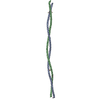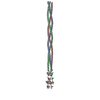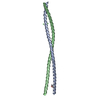[English] 日本語
 Yorodumi
Yorodumi- PDB-6rib: Cryo-EM reconstruction of Thermus thermophilus bactofilin double ... -
+ Open data
Open data
- Basic information
Basic information
| Entry | Database: PDB / ID: 6rib | |||||||||
|---|---|---|---|---|---|---|---|---|---|---|
| Title | Cryo-EM reconstruction of Thermus thermophilus bactofilin double helical filaments | |||||||||
 Components Components | bactofilin | |||||||||
 Keywords Keywords | PROTEIN FIBRIL / Prokaryotic cytoskeletons | |||||||||
| Function / homology | Bactofilin A/B / Polymer-forming cytoskeletal / Polymer-forming cytoskeletal protein Function and homology information Function and homology information | |||||||||
| Biological species |   Thermus thermophilus (bacteria) Thermus thermophilus (bacteria) | |||||||||
| Method | ELECTRON MICROSCOPY / helical reconstruction / cryo EM / Resolution: 4.2 Å | |||||||||
 Authors Authors | Deng, X. / Lowe, J. | |||||||||
| Funding support |  United Kingdom, 2items United Kingdom, 2items
| |||||||||
 Citation Citation |  Journal: Nat Microbiol / Year: 2019 Journal: Nat Microbiol / Year: 2019Title: The structure of bactofilin filaments reveals their mode of membrane binding and lack of polarity. Authors: Xian Deng / Andres Gonzalez Llamazares / James M Wagstaff / Victoria L Hale / Giuseppe Cannone / Stephen H McLaughlin / Danguole Kureisaite-Ciziene / Jan Löwe /  Abstract: Bactofilins are small β-helical proteins that form cytoskeletal filaments in a range of bacteria. Bactofilins have diverse functions, from cell stalk formation in Caulobacter crescentus to ...Bactofilins are small β-helical proteins that form cytoskeletal filaments in a range of bacteria. Bactofilins have diverse functions, from cell stalk formation in Caulobacter crescentus to chromosome segregation and motility in Myxococcus xanthus. However, the precise molecular architecture of bactofilin filaments has remained unclear. Here, sequence analysis and electron microscopy results reveal that, in addition to being widely distributed across bacteria and archaea, bactofilins are also present in a few eukaryotic lineages such as the Oomycetes. Electron cryomicroscopy analysis demonstrated that the sole bactofilin from Thermus thermophilus (TtBac) forms constitutive filaments that polymerize through end-to-end association of the β-helical domains. Using a nanobody, we determined the near-atomic filament structure, showing that the filaments are non-polar. A polymerization-impairing mutation enabled crystallization and structure determination, while reaffirming the lack of polarity and the strength of the β-stacking interface. To confirm the generality of the lack of polarity, we performed coevolutionary analysis on a large set of sequences. Finally, we determined that the widely conserved N-terminal disordered tail of TtBac is responsible for direct binding to lipid membranes, both on liposomes and in Escherichia coli cells. Membrane binding is probably a common feature of these widespread but only recently discovered filaments of the prokaryotic cytoskeleton. | |||||||||
| History |
|
- Structure visualization
Structure visualization
| Movie |
 Movie viewer Movie viewer |
|---|---|
| Structure viewer | Molecule:  Molmil Molmil Jmol/JSmol Jmol/JSmol |
- Downloads & links
Downloads & links
- Download
Download
| PDBx/mmCIF format |  6rib.cif.gz 6rib.cif.gz | 354.6 KB | Display |  PDBx/mmCIF format PDBx/mmCIF format |
|---|---|---|---|---|
| PDB format |  pdb6rib.ent.gz pdb6rib.ent.gz | 296.4 KB | Display |  PDB format PDB format |
| PDBx/mmJSON format |  6rib.json.gz 6rib.json.gz | Tree view |  PDBx/mmJSON format PDBx/mmJSON format | |
| Others |  Other downloads Other downloads |
-Validation report
| Summary document |  6rib_validation.pdf.gz 6rib_validation.pdf.gz | 1 MB | Display |  wwPDB validaton report wwPDB validaton report |
|---|---|---|---|---|
| Full document |  6rib_full_validation.pdf.gz 6rib_full_validation.pdf.gz | 1.1 MB | Display | |
| Data in XML |  6rib_validation.xml.gz 6rib_validation.xml.gz | 53.2 KB | Display | |
| Data in CIF |  6rib_validation.cif.gz 6rib_validation.cif.gz | 82.2 KB | Display | |
| Arichive directory |  https://data.pdbj.org/pub/pdb/validation_reports/ri/6rib https://data.pdbj.org/pub/pdb/validation_reports/ri/6rib ftp://data.pdbj.org/pub/pdb/validation_reports/ri/6rib ftp://data.pdbj.org/pub/pdb/validation_reports/ri/6rib | HTTPS FTP |
-Related structure data
| Related structure data |  4887MC  6riaC M: map data used to model this data C: citing same article ( |
|---|---|
| Similar structure data |
- Links
Links
- Assembly
Assembly
| Deposited unit | 
|
|---|---|
| 1 | 
|
| 2 | 
|
- Components
Components
| #1: Protein | Mass: 13142.075 Da / Num. of mol.: 22 Source method: isolated from a genetically manipulated source Source: (gene. exp.)   Thermus thermophilus (strain HB8 / ATCC 27634 / DSM 579) (bacteria) Thermus thermophilus (strain HB8 / ATCC 27634 / DSM 579) (bacteria)Gene: TTHA1769 / Production host:  |
|---|
-Experimental details
-Experiment
| Experiment | Method: ELECTRON MICROSCOPY |
|---|---|
| EM experiment | Aggregation state: HELICAL ARRAY / 3D reconstruction method: helical reconstruction |
- Sample preparation
Sample preparation
| Component | Name: bactofilin / Type: COMPLEX / Entity ID: all / Source: RECOMBINANT |
|---|---|
| Source (natural) | Organism:   Thermus thermophilus (strain HB8 / ATCC 27634 / DSM 579) (bacteria) Thermus thermophilus (strain HB8 / ATCC 27634 / DSM 579) (bacteria) |
| Source (recombinant) | Organism:  |
| Buffer solution | pH: 11 |
| Specimen | Embedding applied: NO / Shadowing applied: NO / Staining applied: NO / Vitrification applied: YES |
| Vitrification | Cryogen name: ETHANE |
- Electron microscopy imaging
Electron microscopy imaging
| Experimental equipment |  Model: Titan Krios / Image courtesy: FEI Company |
|---|---|
| Microscopy | Model: FEI TITAN KRIOS |
| Electron gun | Electron source:  FIELD EMISSION GUN / Accelerating voltage: 300 kV / Illumination mode: FLOOD BEAM FIELD EMISSION GUN / Accelerating voltage: 300 kV / Illumination mode: FLOOD BEAM |
| Electron lens | Mode: BRIGHT FIELD |
| Image recording | Electron dose: 40 e/Å2 / Detector mode: COUNTING / Film or detector model: FEI FALCON III (4k x 4k) / Num. of real images: 2130 |
- Processing
Processing
| CTF correction | Type: PHASE FLIPPING AND AMPLITUDE CORRECTION |
|---|---|
| Helical symmerty | Angular rotation/subunit: 4.89 ° / Axial rise/subunit: 57.46 Å / Axial symmetry: C1 |
| 3D reconstruction | Resolution: 4.2 Å / Resolution method: OTHER / Num. of particles: 346000 / Details: FSC: map versus refined atomic model / Symmetry type: HELICAL |
| Atomic model building | Protocol: AB INITIO MODEL |
 Movie
Movie Controller
Controller







 PDBj
PDBj